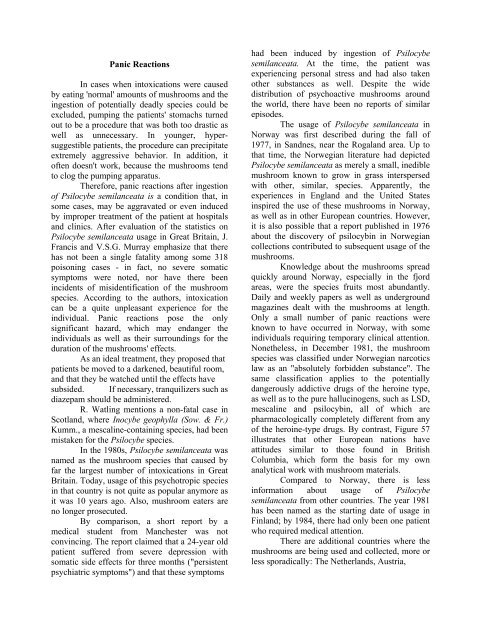Jochen Gartz - Magic Mushrooms Around the ... - preterhuman.net
Jochen Gartz - Magic Mushrooms Around the ... - preterhuman.net
Jochen Gartz - Magic Mushrooms Around the ... - preterhuman.net
You also want an ePaper? Increase the reach of your titles
YUMPU automatically turns print PDFs into web optimized ePapers that Google loves.
Panic Reactions<br />
In cases when intoxications were caused<br />
by eating 'normal' amounts of mushrooms and <strong>the</strong><br />
ingestion of potentially deadly species could be<br />
excluded, pumping <strong>the</strong> patients' stomachs turned<br />
out to be a procedure that was both too drastic as<br />
well as unnecessary. In younger, hypersuggestible<br />
patients, <strong>the</strong> procedure can precipitate<br />
extremely aggressive behavior. In addition, it<br />
often doesn't work, because <strong>the</strong> mushrooms tend<br />
to clog <strong>the</strong> pumping apparatus.<br />
Therefore, panic reactions after ingestion<br />
of Psilocybe semilanceata is a condition that, in<br />
some cases, may be aggravated or even induced<br />
by improper treatment of <strong>the</strong> patient at hospitals<br />
and clinics. After evaluation of <strong>the</strong> statistics on<br />
Psilocybe semilanceata usage in Great Britain, J.<br />
Francis and V.S.G. Murray emphasize that <strong>the</strong>re<br />
has not been a single fatality among some 318<br />
poisoning cases - in fact, no severe somatic<br />
symptoms were noted, nor have <strong>the</strong>re been<br />
incidents of misidentification of <strong>the</strong> mushroom<br />
species. According to <strong>the</strong> authors, intoxication<br />
can be a quite unpleasant experience for <strong>the</strong><br />
individual. Panic reactions pose <strong>the</strong> only<br />
significant hazard, which may endanger <strong>the</strong><br />
individuals as well as <strong>the</strong>ir surroundings for <strong>the</strong><br />
duration of <strong>the</strong> mushrooms' effects.<br />
As an ideal treatment, <strong>the</strong>y proposed that<br />
patients be moved to a darkened, beautiful room,<br />
and that <strong>the</strong>y be watched until <strong>the</strong> effects have<br />
subsided. If necessary, tranquilizers such as<br />
diazepam should be administered.<br />
R. Watling mentions a non-fatal case in<br />
Scotland, where Inocybe geophylla (Sow. & Fr.)<br />
Kumm., a mescaline-containing species, had been<br />
mistaken for <strong>the</strong> Psilocybe species.<br />
In <strong>the</strong> 1980s, Psilocybe semilanceata was<br />
named as <strong>the</strong> mushroom species that caused by<br />
far <strong>the</strong> largest number of intoxications in Great<br />
Britain. Today, usage of this psychotropic species<br />
in that country is not quite as popular anymore as<br />
it was 10 years ago. Also, mushroom eaters are<br />
no longer prosecuted.<br />
By comparison, a short report by a<br />
medical student from Manchester was not<br />
convincing. The report claimed that a 24-year old<br />
patient suffered from severe depression with<br />
somatic side effects for three months ("persistent<br />
psychiatric symptoms") and that <strong>the</strong>se symptoms<br />
had been induced by ingestion of Psilocybe<br />
semilanceata. At <strong>the</strong> time, <strong>the</strong> patient was<br />
experiencing personal stress and had also taken<br />
o<strong>the</strong>r substances as well. Despite <strong>the</strong> wide<br />
distribution of psychoactive mushrooms around<br />
<strong>the</strong> world, <strong>the</strong>re have been no reports of similar<br />
episodes.<br />
The usage of Psilocybe semilanceata in<br />
Norway was first described during <strong>the</strong> fall of<br />
1977, in Sandnes, near <strong>the</strong> Rogaland area. Up to<br />
that time, <strong>the</strong> Norwegian literature had depicted<br />
Psilocybe semilanceata as merely a small, inedible<br />
mushroom known to grow in grass interspersed<br />
with o<strong>the</strong>r, similar, species. Apparently, <strong>the</strong><br />
experiences in England and <strong>the</strong> United States<br />
inspired <strong>the</strong> use of <strong>the</strong>se mushrooms in Norway,<br />
as well as in o<strong>the</strong>r European countries. However,<br />
it is also possible that a report published in 1976<br />
about <strong>the</strong> discovery of psilocybin in Norwegian<br />
collections contributed to subsequent usage of <strong>the</strong><br />
mushrooms.<br />
Knowledge about <strong>the</strong> mushrooms spread<br />
quickly around Norway, especially in <strong>the</strong> fjord<br />
areas, were <strong>the</strong> species fruits most abundantly.<br />
Daily and weekly papers as well as underground<br />
magazines dealt with <strong>the</strong> mushrooms at length.<br />
Only a small number of panic reactions were<br />
known to have occurred in Norway, with some<br />
individuals requiring temporary clinical attention.<br />
None<strong>the</strong>less, in December 1981, <strong>the</strong> mushroom<br />
species was classified under Norwegian narcotics<br />
law as an "absolutely forbidden substance". The<br />
same classification applies to <strong>the</strong> potentially<br />
dangerously addictive drugs of <strong>the</strong> heroine type,<br />
as well as to <strong>the</strong> pure hallucinogens, such as LSD,<br />
mescaline and psilocybin, all of which are<br />
pharmacologically completely different from any<br />
of <strong>the</strong> heroine-type drugs. By contrast, Figure 57<br />
illustrates that o<strong>the</strong>r European nations have<br />
attitudes similar to those found in British<br />
Columbia, which form <strong>the</strong> basis for my own<br />
analytical work with mushroom materials.<br />
Compared to Norway, <strong>the</strong>re is less<br />
information about usage of Psilocybe<br />
semilanceata from o<strong>the</strong>r countries. The year 1981<br />
has been named as <strong>the</strong> starting date of usage in<br />
Finland; by 1984, <strong>the</strong>re had only been one patient<br />
who required medical attention.<br />
There are additional countries where <strong>the</strong><br />
mushrooms are being used and collected, more or<br />
less sporadically: The Ne<strong>the</strong>rlands, Austria,








![The Big Lie 9-11 and Government Complicity in Mass Murder [PDF]](https://img.yumpu.com/50957077/1/190x245/the-big-lie-9-11-and-government-complicity-in-mass-murder-pdf.jpg?quality=85)








